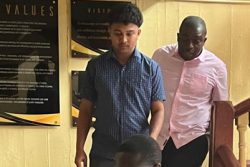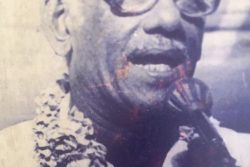Last Saturday’s back page Stabroek Sports story, ‘NSC big three visit facilities being upgraded,’ the aforementioned ‘big three’ being Minister of Culture, Youth and Sport, Charles Ramson, Director of Sport, Steve Ninvalle and Chairman of the National Sports Commission (NSC) Kashif Mohammed, secured conspicuously prominent occupancy of space in circumstances where a persuasive argument might have been made for supplanting it with the Golden Jaguars’ inglorious defeat by a 3-0 margin at the hands of St. Kitts and Nevis on the previous evening. The outcome of the game led, entirely justifiably, to the newspaper’s description of ‘our boys’ performance as “abject.” Our football, one feels, will have to continue to endure such calumnies until we get it into our heads that like in any other field of endeavour that serves as a barometer with which to measure the calibre of a country, football, too, requires the studied attention of functionaries with the requisite levels of both managerial acumen and technical skills necessary to take the standard of our game forward. How to motivate players to give of their best is not simply a matter of understanding football; it is also about understanding people.
Over many years the Guyana Football Federa-tion (GFF) has been unable to afford us any persuasive evidence that it can furnish football with the deliverables necessary for us to raise our national game. As an aside it would be a travesty, no less, if the outcome of the St. Kitts and Nevis game does not cause the present leadership of the Federation to go quietly, though from what we know of the mindset of the principals, hell is likely to freeze over first.
Leaving aside the travails of local football one returns to the matter of ‘the big three’ wherein lies more profound issues that have to do with sport as a whole and with just where we are headed. What are we to make of this ‘big three’ epithet? It points, unerringly (or at least so it seems) to the full and complete emergence of the triumvirate which, for the time being at least, will function as the Czars of Sport. One assumes, of course, that Minister Ramson and his ‘lead players’ are not only aware of the adage that counsels to the effect that ‘to whom much is given much is expected’ and that such eye-catching headlines as appeared in the aforementioned Stabroek News back page story tend to live in people’s memories and that these carry with them pressures and expectations and generous measures of recrimination if those expectations were to come to dissolve into failure.
Both Mohammed and Ninvalle have, in separate ways, provided some measure of evidence of their various competencies, Mohammed as the Czar of the Kashif & Shanghai Football Tourna-ment and Ninvalle as an experienced and capable sports journalist and a former senior functionary in the Ministry of Sport under an earlier political administration. Minister Ramson is, one feels, an ambitious newcomer to high profile politics who, is astute enough to understand that if he can make a fist of the Sport portfolio upward mobility could follow. Frankly, it is entirely fair to say that Minister Ramson probably regards his present portfolio as a means to a more exalted political end. And why not?
Global perceptions of the significance of sport have, of course, metamorphosed over the years, moving beyond the mere public parading of a nation’s athletic prowess. These days, sport confers other distinctions that have to do with nations’ global image and as well with their material well-being. Sport has proven, in instances that can easily be recalled, to be the engine that drives the global marketing of countries. In the particular instance of Guyana we have failed, up until now, to derive any really meaningful national return from sport.
The simple truth, however much we deny it, is that we have never treated sport as though it were integral to our wider development and as a vehicle that can be pressed into service to help market Guyana in myriad other ways. We have talked the talk about sport being ‘a nation builder’ but we have never seriously walked the walk. We have always treated sport as though it merited no more than marginal official attention, not even bothering, to our eternal shame, to take leaves out of the books of those other CARICOM countries whose sportsmen and women have significantly illuminated the profiles of their respective countries on the international stage.
How does all this fit in with the recent ‘anointing’ of the “big three.” They need to understand that sport in Guyana has passed this way before and that their anointing can either set a precedent for crowning success, or else, metamorphose into an onerous burden, marking them down as failed triers. The reality here is that we have arrived at a juncture where yet another failure to secure a more worthwhile local and (eventually) global profile for sport will not be easily forgotten or forgiven.
One of the challenges that come with ‘the big three’ sobriquet is that it holds the triumvirate up to a higher order. It compels them to present themselves as agents of genuine and meaningful change and does not afford them the luxury of the calumny of ‘wrong turns’ and blind alleyways that have been almost the whole of our previous experience. Sport as a national pursuit can no longer be allowed to drift along on a tide of incompetence and indifference to outcomes. It has to be afforded the facility of a steadier ship the course of which is piloted by far more certain and capable hands than those that have served us, previously, and even now, clad in their raiment of failure, continue to haunt the corridors of national sport. We have to begin to redefine sport and to fashion the national sport agenda that links its purpose to our broader developmental objectives. It is this holistic, vision-driven mission that we look to ‘the big three’ to help deliver.









